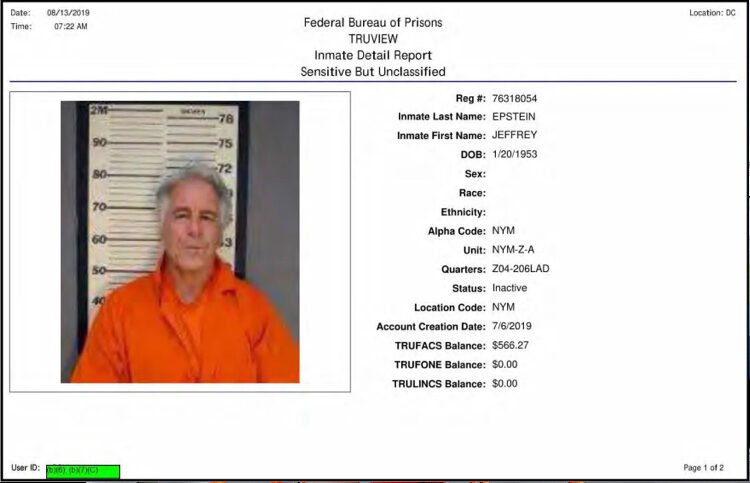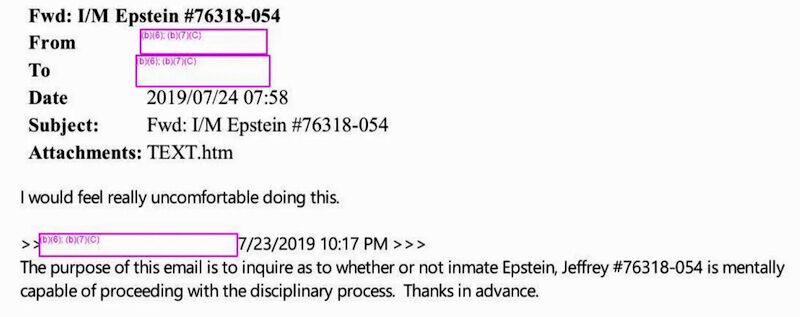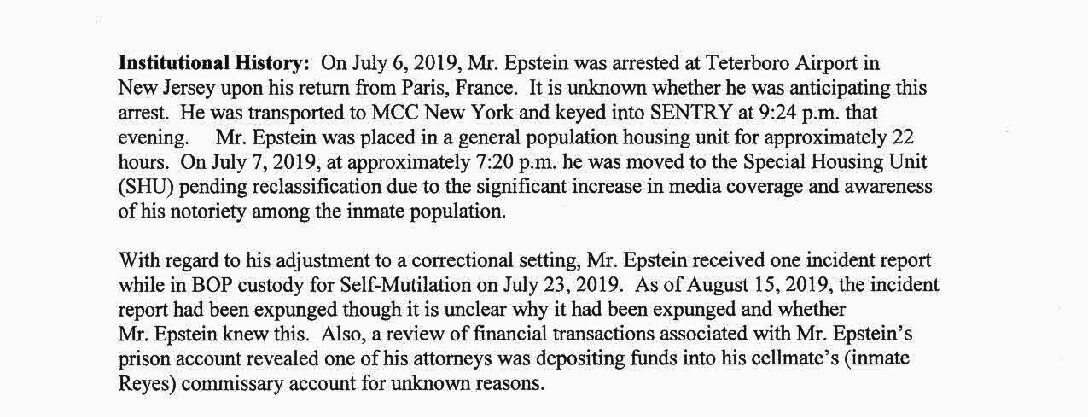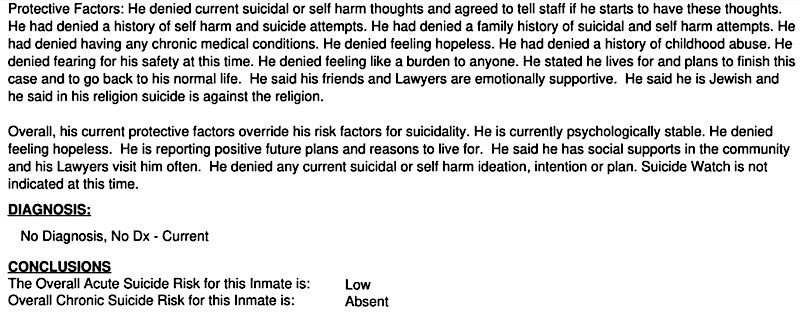Internal US Bureau of Prison (BOP) documents obtained by The Grayzone under Freedom of Information laws raise extremely serious questions about whether Jeffrey Epstein's alleged first suicide attempt on July 23, 2019 in fact happened, and suggest the Bureau distorted evidence to attribute his death to suicide before his autopsy had even been completed. This meant the narrative of suicide was pushed on the public - to the exclusion of all other explanations - before basic facts were ascertained.
The release in January of previously sealed court documents detailing official investigations and civil lawsuits leveled against Epstein has reignited public interest in the late sex offender. Yet establishment journalists have poured cold water on the disclosures, assuring readers they do not offer anything new or of any import, while strongly implying the many shocking accusations they contain are bogus. References to Epstein's apparent death are largely absent from mainstream reporting.
Officially, Epstein was found to have died in his cell at New York City's Metropolitan Correctional Center on August 10, 2019, with a medical examiner ruling at the time that he had taken his own life by hanging. The ruling was aggressively contested by Epstein's associates and widely disbelieved by the public, with one poll suggesting just 16% of Americans think he committed suicide.
There was good reason for their skepticism. Epstein's legal team publicly declared available evidence on his death was "far more consistent" with murder. Dr. Michael Baden, a leading forensic pathologist who monitored the autopsy, also claimed its findings "did not support suicide." Moreover, knowledgeable sources revealed broken bones in Epstein's neck were "more common in victims of homicide by strangulation."
When a long-awaited Justice Department report on Epstein's "custody, care, and supervision" by the BOP while briefly incarcerated was released in June 2023, it too was greeted with near-complete indifference by legacy media. Now, The Grayzone has secured the internal Bureau documents which indicate that efforts to cover up Epstein's suspicious death were more extensive than previously known, and included prison staff.
'Lacerated' or not?
The official inquiry by the Department of Justice Inspector General states that on July 23, 2019, nearly three weeks before his death, Epstein was found injured and semi-conscious in his cell, with marks of an unspecified nature around his neck. Per the report, he subsequently claimed to know nothing about the incident, which took place just two-and-half-weeks following his imprisonment on charges of child sex trafficking. Epstein's cellmate, former New York police officer Nicholas Tartaglione, also pleaded ignorance. (Tartaglione previously shared legal representation with Ghislaine Maxwell, Epstein's partner and 'madam.' He was convicted in April 2023 of killing four men, shooting three and strangling one to death.)
Within minutes of Epstein's alleged discovery by prison guards, BOP officials formally logged the inmate's attempted suicide via "hanging/asphyxiation" in internal records. Sections of the report describing what precisely occurred are redacted, as is the author's name. The prisoner's account of how he sustained his purported injuries, provided in a medical examination five hours later, is also concealed from public view in the now-released files.
The records show that the following day, Epstein was removed from suicide watch and charged with violating prison code 228, which covers "tattooing or self-mutilation." It is unclear why this took place. In internal communications, one BOP official openly pondered whether Epstein was "mentally capable of proceeding with the disciplinary process." Another incongruously said of the disciplinary hearing: "I would feel really uncomfortable doing this."
Curiously, on July 30, the official incident report was updated to include "self-mutilation" as the cause of Epstein's failed suicide, citing indeterminate "lacerations." However, an examination by prison doctors just hours after he allegedly tried to take his life mentioned zero lacerations. A subsequent memo by a prison psychologist noted that "Epstein had a poor attitude" in interviews and refused to discuss the matter, but concluded that the amended incident report was "accurate," and allegation of attempted suicide "warranted."
A memo issued after the incident eerily notes that Epstein's "self-mutilation" was "expunged" from official records. Just five days after Epstein's death, a BOP representative remarked it was "unclear why it had been expunged and whether Mr. Epstein knew this." Mainstream media has not acknowledged this peculiar episode since the memo appeared. It has also ignored the critical question of whether the alleged incident ever took place at all - or whether it was fabricated to bolster the case for suicide.
Epstein placed on suicide watch despite having "denied...suicidal or self-harm thoughts"
The BOP records show Epstein complained frequently to authorities about the conditions of his incarceration. His cell toilet lacked sufficient paper, and flushed continuously for extended periods, he said, and his cellmate apparently yammered on incessantly, especially at night. But there is nothing in the files to suggest that Epstein ever felt threatened or depressed. In fact, several psychological assessments conducted at the jail indicate he was optimistic about his prospects. One evaluation noted that he explicitly denied "suicidal ideation, planning, and intent," and was "[committed] to life and safety."
"[Epstein] exhibited a neutral affect with appropriate range. Eye contact and hygiene were appropriate... His thoughts were organized and coherent, with no loosening of associations or tangential, circumstantial, or irrelevant content... There was no evidence of perceptual disturbance, delusional ideation, or a formal thought disorder. He did not engage in any bizarre or inappropriate behavior."Another appraisal detailed "protective factors" Epstein enjoyed, citing conversations in which he "denied current suicidal or self-harm thoughts," or "feeling hopeless." He also "denied fearing for his safety," and outlined "plans to finish this case and to go back to his normal life."
He praised his "emotionally supportive" friends and lawyers and said that, as a practicing Jew, he abhorred suicide, the report noted. Given that the "overall acute suicide risk for this inmate" was "low" and the "overall chronic suicide risk for this inmate" was "absent" entirely, the BOP concluded: "suicide watch is not warranted at this time."
Despite Epstein's apparent aversion to taking his own life, he was placed on suicide watch. Detailed accounts were filed every 15 minutes by guards on his activities, which included "lying quietly in bed" and "pacing around his cell." Oddly, this decision was rescinded on July 24 2019, the day after he allegedly attempted suicide.
Six days later, he gained a new cellmate, Efrain Reyes. But on August 9, Reyes was inexplicably removed, leaving Epstein alone — a flagrant breach of internal procedures.
The BOP files indicate the urgent need for a new cellmate for Epstein was communicated between day and evening watch shifts at the jail. But none arrived. Regular checks on the inmate also ceased. Three CCTV cameras nearby apparently malfunctioned. Two on-duty guards fabricated records to hide how they allegedly flouted their legal duties to surf the internet. And the next day, the prison's most infamous inmate was dead.
The pair of guards were subsequently charged with falsifying prison records, a serious criminal offense. However, on December 13 2021, the charges were dropped, and they walked free. The public did not learn this until December 31, two days after Ghislaine Maxwell was found guilty of trafficking young girls for sexual abuse on Epstein's behalf.
BOP officials manage the narrative of Epstein's death
The unsealed BOP documents demonstrate how in the immediate wake of Epstein's death, Bureau of Prisons officials immediately assured journalists and members of Epstein's family that he had committed suicide. The obedient media went to work, unquestioningly broadcasting the conclusion before an official autopsy was conducted.
Three days later, BOP suicide prevention coordinator Robert Nagle visited the Metropolitan Correctional Center to initiate a "psychological reconstruction" of Epstein's last moments. His resultant report recorded that a video of the "significant incident" was confiscated by the FBI before his review began. He was also prohibited from conducting formal interviews with prison staff, supposedly in an effort "to avoid interference with pending investigations" by the Justice Department. As a result, he noted that information he "typically gathered" for psychological reconstructions was unavailable.
These constraints meant Nagle was not able "to establish accurate timelines, confirm subjective reports, establish converging and diverging lines of facts, or discover new areas of inquiry." Nor could he compile a "detailed description" of what guards found when they discovered Epstein, as they "did not write memorandums and could not be interviewed." Many sections of reconstruction — including a review of Epstein's "social history" at the jail — were thus incomplete.
Nevertheless, Nagle ruled conclusively that Epstein committed suicide. The alleged decision is attributed to a supposed "inability to tolerate the noise of prison," as well as the likelihood of a life sentence, a prospect made more likely when thousands of records related to his 2008 conviction on child sex offenses were unsealed. Additionally, a comment by Epstein privately declaring himself to be a "coward" in the weeks prior to his alleged suicide was repeatedly cited as proof of suicidal intent.
But a review of the internal BOP files reveals Epstein made those statements while explicitly denying any intention, or even ability, to kill himself. A prison psychological assessment concluded: "He is not the type who likes pain or would ever attempt to harm himself...[He] even does not like when he has to give blood."
This brazen distortion went unmentioned in an internal review of the reconstruction authored by Metropolitan Correctional Center Warden Marti Licon-Vitale. Nonetheless, in a section marked "documentation accuracy," she took BOP officials to task for amending their report on Epstein's alleged failed suicide attempt:
"Professional responsibility requires taking into account multiple descriptions of an incident... When discrepancies exist these should be compiled and noted in documentation to decrease the likelihood of conflicting conclusions. Preconceived notions challenge the ability to remain open about alternative explanations."Such grievances aside, Nagle's reconstruction received praise in internal communications between BOP officials, likely because it disingenuously tied up many loose ends in the narrative of Epstein's death. On August 23, agency director Hugh Hurwitz effused over the "outstanding" work, calling it "unbelievable" the report was composed "without the benefit of interviews or video." The same could be said by any skeptical observer with the capacity for irony.
In its reporting on the BOP's "psychological reconstruction" of Epstein's death, the New York Times acknowledged the inmate's insistence that he had no intention to commit suicide as a testament to his "life of manipulation," peerless deception skills, and ability to "[create] illusions." An obvious alternative interpretation is that Epstein was sincere in his denials, and did not commit suicide.
The sudden death of Epstein's former cellmate
The New York Times obtained the same trove of BOP files as The Grayzone, yet it only reported on the "psychological reconstruction" of Epstein's death described in the documents. Oddly, the Times did not acknowledge that the "psychological reconstruction" indicated that financial transactions associated with Epstein's prison stay revealed one of his attorneys "was depositing funds" into the prison account of his cellmate Efrain Reyes, "for unknown reasons." It is no wonder then that he became a person of interest in the FBI's investigation of Epstein's death. In return for his help, he was moved to a minimum security prison, which housed high-value cooperating witnesses.
Five months after his release from the prison due to a facility-wide COVID-19 outbreak, Reyes died. The purported cause of death was complications from the virus. His niece subsequently told reporters her uncle frequently voiced doubts the six-foot-tall Epstein could have hanged himself from the bunk frame in his cell.
In January 2021, federal prosecutors rejected journalists' requests for full disclosure on the death of Reyes, ruling that all records it held on Epstein's former cellmate would remain sealed. In dismissing the media's transparency demands, authorities provided two pages of information about Epstein in the files related to Reyes. However, all of it was redacted.
About the Author:
Kit Klarenberg is an investigative journalist exploring the role of intelligence services in shaping politics and perceptions.








Reader Comments
Non Jews are a commodity like cattle to be manipulated and harvested when need be. They are less human than Jews. Jews are special and privileged. Non Jews are a resource. That about sums up the Talmudic beliefs as I understand them.
Ironically not much difference from hard line Islam.
I would, however, disagree on the part about Islam. Those ‘hardliners’ are really for the most part the Wahhabist sect, or groups and individuals financed or otherwise knowingly or unknowingly influenced by the House of Saud—the greatest dispersers of that ideology today, staunch allies of the hegemon and, ironically, Muslim only at passing inspection.
Mainstream Islam demands all ‘People of the Book’ be treated with respect, and they had a rather good record with that throughout the middle ages, after Islam’s conquest phase and before it was twisted to serve the needs of certain shadowy profiteers.
Except agents do grow old and need to retire as do the operations they take part in need to be wrapped up and refreshed somewhere new.
"Jeff" is likely on a warm beach somewhere with a decent pension and a new identity. You can't kill your loyal agents or nobody is going to do the job in the future.